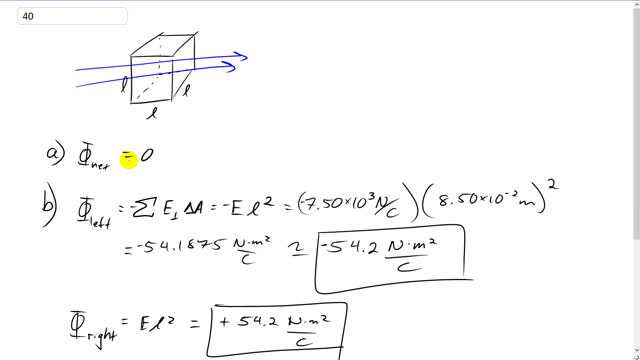
A cube of side 8.50 cm is placed in a uniform field with edges parallel to the field lines.
- What is the net flux through the cube?
- What is the flux through each of its six faces?
- Zero
- the side where the field lines enter the box has a flux of , whereas the opposite side has flux of the same magnitude but opposite sign. All other sides have zero flux.

In order to watch this solution you need to have a subscription.
This is Giancoli Answers with Mr. Dychko. Here's our cube with edges parallel to the electric field lines drawn in blue, and the cube, it's side is l. The net flux is gonna be zero because there's no flux through these surfaces that are not being intercepted by the field lines. This top surface, and the front surface, and the bottom surface, and the back surface have no fluxes at all. This surface here does have some flux but this surface has the same flux with opposite sign. What's going in is also coming out, so there's no net flux here at all. Zero is the answer for part A. Now the flux through the left surface is gonna be negative because if you consider a positive charge here, we already know that the field lines radiate outwards from a positive charge, because you put a positive test charge somewhere here, it'll experience the force going away due to repulsion. So if you put a Gaussian surface around that charge, you see that the flux is going outwards, and so this flux must be positive because since flux equals the enclosed charge divided by Ε naught you know that the enclosed charge is positive because that is what I just said. It's a positive charge there. So in order for this Q enclosed to be positive, that means that the flux must be positive in this scenario. So flux is positive according to these field lines when the lines are going outwards, out of the volume enclosed by the Gaussian surface. The flux to the right-hand phase here is positive because the field lines are going out of that, out of the volume through that surface, and they're entering the volume through the left-hand surface, and so the flux to the left-hand surface is negative. And the flux is gonna be the sum of the flux over every little bit of area but the perpendicular component of the electric field in every area is just gonna be electric field times l squared because this is a nicely chosen geometry here where every-- I guess if I were to explain this, it gets a little bit complicated but this is like the sum of the electric field strength which is constant everywhere times a little bit of area, a little tiny square of area, and a little area one plus same field times little area two plus the same field, times a little bit of area three, a little square is here. Then you can factor out the E perpendicular from this all of this terms because it's the same everywhere. And then you're left with A one plus A two plus A three which will be the total area of the surface which is just l squared. So electric field strength is 7.5 times 10 to the three Newtons per Coulomb, and we multiply it by the area which is 8.5 times 10 to the minus two meters squared, and that gives negative 54.2 Newton meters squared per Coulomb. And the flux to the right surface is gonna have the same magnitude but it will be positive, positive 54.2. And then the flux through all the other surface is zero since there is no component of the electric field perpendicular to any of the other surfaces.